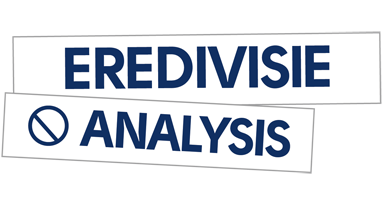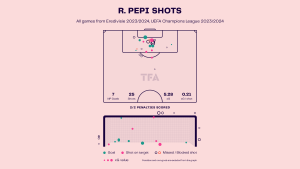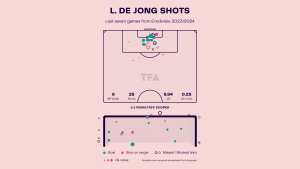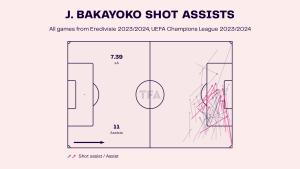Following the curtailing of the 2019/20 Eredivisie league season due to the coronavirus pandemic, we head into the 2020/21 campaign with no defending champions. Ajax, the last team to win the division back in 2018/19, will expect themselves to fire on all cylinders to remain top of the pack in Holland. Despite losing two key players this summer following Hakim Ziyech’s move to Chelsea and Manchester United singing Donny van de Beek, many may assume that Ajax would lose their way and struggle without them. In fairness, this was often the case in 19/20 if one of the pair were absent – Ajax lacked creativity and attacking intensity. But, if Ajax’s pre-season form is anything to buy, it would seem they have effectively altered their game to suit their current squad. A tough test against Frankfurt of the Bundesliga would give us all a strong idea of the progress Ajax are making, and a 2-1 victory accompanied with some dazzling football will excite the fans. This match report will provide a tactical analysis of a selection of Ajax’s attacking concepts, combined with an analysis of their tactics off the ball.
Lineups
Ajax lined up in a familiar formation of 4-2-3-1, a shape to fit their system perfectly, and the shape they will likely continue with for the most part of the season. Andre Onana appeared between the sticks, filling fans with hope that he may stick around for the season. From right to left, Ajax’s back four consisted of Noussair Mazraoui, Lisandro Martínez, Perr Schuurs, and Nicolás Tagliafico. Edson Álvarez and Ryan Gravenberch occupied the two deeper central midfield roles, with new (and record) signing Antony playing on the right wing; Dusan Tadić on the left. Quincy Promes played in an advanced midfield role, with 19-year-old Lassina Traoré leading the line.
Visitors Eintracht Frankfurt, who finished a respectable ninth in the Bundesliga in 19/20, deployed an interesting 3-4-1-2 formation – not a shape Ajax are used to facing, particularly at home. The experienced Kevin Trapp played in the goal and was the only Frankfurt player not to be substituted at some point during the game. David Abraham, Martin Hinteregger, and Evan N’Dicka made up the back three for the Germans. Danny Da Costa and Filip Kostić played right wing back and left wing back respectively. Sebastian Rode and Stefan Ilsanker were to the two centre midfielders, with Daichi Kamada just in front. André Silva and Ragnar Ache were the strikers for the visitors.
Ajax’s defensive shape

Firstly, we shall take a look at how Ajax shaped up when Frankfurt had comfortable possession in their half. The home side were quick to retreat into shape after Frankfurt opted to avoid the counterattack, instead looking to execute a patient attack and retain possession. Ajax’s back four was well organised and narrow, minimising the gaps to be exploited via a through pass – also helped by their depth: neither too deep nor high. The three highlighted Ajax midfielders all play their part in a defensive system. While two of them mark an opponent each to limit passing options, the third player, Gravenberch, is located just behind Tadić, who is pressing the opponent. Gravenberch’s role in this scenario is to screen – protecting the back line from any passes as well as taking up that space, making it hard for Frankfurt to exploit. He is also acting as secondary support for Tadić should the winger be beaten.

Ajax are a side who play with a lot of energy and intensity on the ball – they’re often the same off it, especially either when they’ve just lost possession or a pressing trigger such as a bad pass or touch occurs. In this scenario, Frankfurt are caught out as they try to play out from the back following a turnover in possession. The highlighted centre half attempts a risky pass into the central midfielder. Why is this so risky? Well, Traoré is placed between the passer and the recipient, cancelling out a return pass; Mohammed Kudus and Martinez both apply intense pressure from behind, not allowing the Frankfurt player to turn out without hitting trouble. In a moment of panic, he attempts to find his teammate at right back. Tadić, however, is on his toes while the full-back is on his heels, and he intercepts pass, completing a successful counterpress from the home side, allowing them to attack.
During this fixture, Ajax made a total of 111 recoveries, more than their opponents. A lot of their success in regaining possession is knowing when to execute counterpressing and force the opponent into making a mistake – a factor of Ajax’s game they have mastered over recent seasons.

As we have just mentioned, there is a skill to knowing when and where to apply a high-intensity counterpress. Similarly, there must be good communication and unit understanding for what is going on in the analysis above. Off the ball, the front four for Ajax act as one unit, often in this diamond shape, to apply pressure to the opponent in the right areas. Traoré will often spearhead the press, usually to the goalkeeper or centre half. The wingers will tuck in slightly, just in front of the high and wide Frankfurt wing-backs. And the advanced midfielder, the bottom of the diamond, will do one of two jobs: apply pressure to a central passing option like above, or act as a screening figure to pick up any loose balls as a result of the press.
While Ajax may not directly regain possession from actions like this, it forces the opponent to make a decision and act quickly to avoid gifting Ajax with a golden chance. The alternative would be for this unit of four to drop back with the rest of the midfield, allowing Frankfurt to bring the ball, and themselves, higher up the pitch.
Ajax playing out from the back

Ajax like to defend from the front, and attack from the back. Very rarely will you see them launch a long hopeless ball to avoid danger. Above, we see one way they like to play out from the back. Here is where we can see that manager Eric ten Hag has worked alongside Pep Guardiola in the past – often in a Guardiola side we will see the two centre backs split, and a deep midfielder drop in to almost create a triangular shape between the three. This system of play works well in scenarios like this because Frankfurt haven’t committed many players to a press – two players simply remain floating to cover the space. Onana, a competent keeper with the ball at his feet, has three safe but effective passing options. Regardless of which passing option he takes, Ajax will still look to find a full back with the next pass as that is the side’s natural way of attack. Furthermore, playing this way allows Ajax to quickly but safely bypass the two players applying minimal pressure, allowing them keep the full-backs in supporting roles and create overloads further up the pitch.

Former Ajax star Frenkie de Jong was a player with an array of talents, capable of operating a number of roles. One innovative move Ajax developed with the Dutch international occurred when Ajax had comfortable possession at the back. As discussed, occasionally Ajax will commit their full-backs into high and wide positions, which is the case above. To allow for a more fluid type of football to be played from the back, de Jong would often drop alongside the two central defenders, essentially making a back three, giving the full backs even more of an attacking licence. Judging by Gravenberch’s performance in this game, this is something Ajax are looking bring back into their game, after not utilising it last season. Gravenberch fits the profile for this role perfectly thanks to his defensive capabilities and his talent on the ball.
Ajax’s attacking approach

Ajax are masters at making this kind of approach look easy. With three passes, they managed to take possession from a defensive area with Tagliafico, to Traoré running clean through on goal. But how? As we can see, Kudus, the Ajax player marked blue, is receiving the ball from Tagliafico, but the two Frankfurt players closing him down started to apply pressure far too late – by this point, Kudus is already making his pass to Tadić out wide. To make matters worse for Frankfurt, and a whole lot easier for Ajax, the Frankfurt man in the middle marked white is actually a centre half, who has left his post to make a reckless attempt to close Kudus down. This opens up a huge gap in the Frankfurt defence, which Tadić and Traoré immediately notice. From here, the forward is able to run in on goal, and the move concludes with Ajax conducting a smart piece of combination play before Kudus netting Ajax’s second of the game. This deadly style of attack has been something ten Hag’s men have been capable of for a while – of course having an opposition defender charge out of position only helps them.


Tactical and attacking innovation isn’t a new element for Eric ten Hag and Ajax. They have been executing eye-catching and unconventional attacking methods for a while now, and it seems they have added another move to their arsenal. Usually, as mentioned, the full backs for Ajax will support attacks from a high and wide position, often hugging the touchline. However, against Frankfurt we see either full back support the attack in an alternative way. In both images above, we see Mazraoui and Tagliafico respectively well involved with an attack but located much further inside than you would expect. While one is making a run without the ball, and the other is carrying the ball, this doesn’t alter their overall responsibility in the role of an inverted wing back. Tucking inside in this fashion essentially adds another body to the midfield unit when in attack, which means the opposition must deploy more bodies in the middle too. This leaves the wingers on either side with a lot more room, allowing Ajax to get them into more dangerous areas to create chances. Additionally, their positioning also creates more space for their midfield teammates as there will likely be less players to mark them and the space in front of the opposition back line.

Ajax have a fondness for creating chances via their wide attacking players, as there is often more space to be exploited in those zones. In this scenario, it is worth noting how late in the game it is, with Ajax leading. Despite these two factors, wingers on either side are still committed to an attack in wide areas without an opponent close to them. This can be particularly effective in this context as the losing side will be committing more men forward in search of an equaliser, leaving Ajax with less players to bypass in the final third. With Frankfurt playing three at the back, this forces them into one of two options: deploying a narrow and compact shape to protect the penalty area when Ajax reach it – which only invites Ajax to find the wide player in space; or allow the two wider centre backs to mark a winger, leaving Ajax with a potential two-on-one scenario in the middle, in their favour.
While it is true that Ajax won’t have the luxury of numbers when the opponent isn’t searching for an equaliser, the importance of their wingers cannot be overlooked. In this game, Ajax registered 63% possession, with 16 shots on goal, along with six total counter attacks. The high and wide positioning of the wingers allow for Ajax to play a possession-based game and try to stretch the opponent or draw them out of position. Their positioning is also vital in counterattacks as there are usually more gaps to be exploited, especially against a side playing three at the back.
Conclusion
Despite losing two of their biggest stars in the same transfer window, Ajax’s summer recruitment and their continuous development of young talent means they have squad that looks impressive and ready for the season. Against Frankfurt, they attacked with intent and innovation, often playing too quick for the Bundesliga side to stop them. In areas, it is clear that there is improvement to made with this Ajax side, but that only means they will become more and more dangerous as the season progresses.










